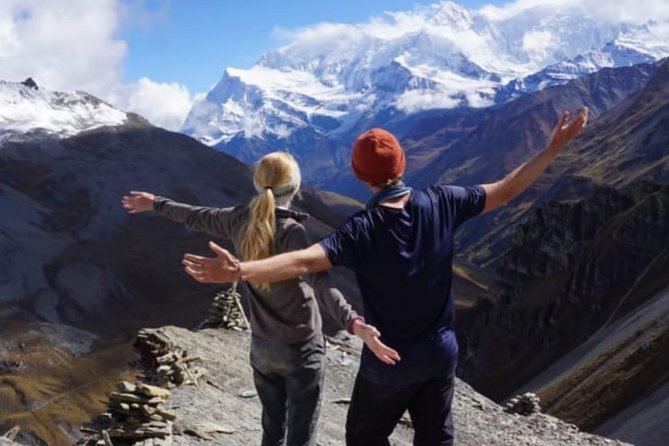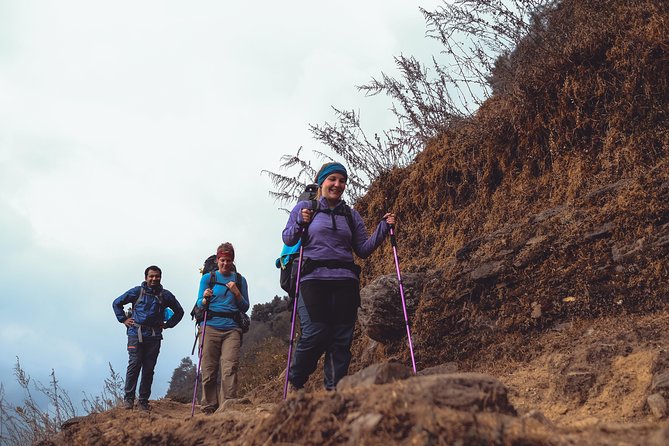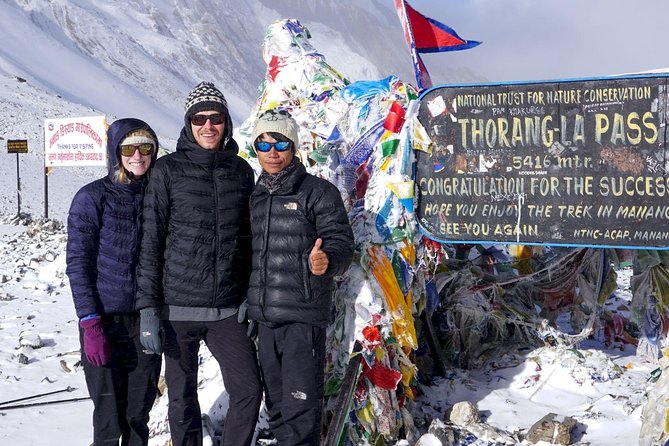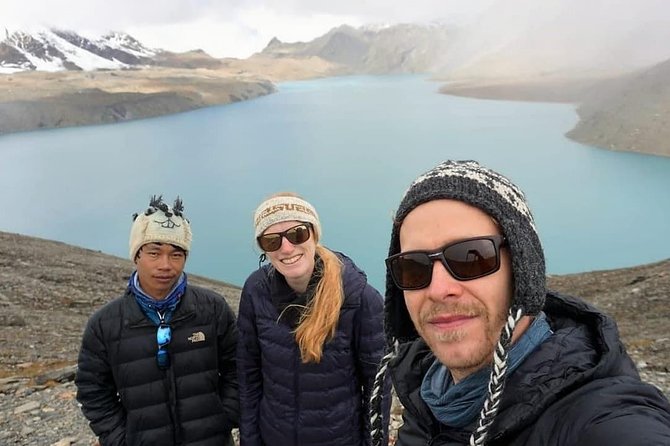The Annapurna Circuit Trekking spans 15 days of exhilarating exploration, where trekkers navigate diverse landscapes and enjoy local cultures. From the breathtaking heights of Thorong La Pass to the serene valleys inhabited by the Gurung and Thakali communities, this journey offers more than just stunning views. It combines physical challenge with cultural richness, making it a unique experience. As they prepare for this adventure, trekkers often ponder the essential details that could make or break their trek, particularly when it comes to preparation and safety. What should be on their checklist before embarking on this remarkable journey?
Good To Know

- The Annapurna Circuit Trek spans 15 days, culminating at the stunning Thorong La Pass at 5,416 meters.
- The trek features diverse landscapes, including the world’s deepest gorge, Kali Gandaki, and breathtaking views of the Annapurna Massif.
- An acclimatization day in Manang allows trekkers to adjust to the altitude and explore local culture.
- The journey includes interactions with Gurung and Thakali communities, providing rich cultural experiences and insights.
- The trek is designed for moderate fitness levels, accommodating varying paces and ensuring a manageable experience for all trekkers.
Overview of the Trek

The Annapurna Circuit Trek is an exhilarating journey that offers trekkers a unique blend of stunning natural beauty and rich cultural experiences.
Spanning 15 days, this trek demands a moderate level of physical fitness, making it accessible for many adventurers. The trek culminates at Thorong La, standing at 5,416 meters, and traverses the world’s deepest gorge at Kali Gandaki.
Along the way, trekkers will witness the breathtaking snow-capped peaks of the Annapurna Massif and the Dhaulagiri Range.
Plus, the trek immerses participants in the local lifestyle and traditions of the diverse communities within the Annapurna Conservation Area, providing a deeper understanding of the region’s ecology and culture.
It’s an unforgettable experience that combines challenge with beauty and discovery.
You can also read our reviews of more tours and experiences in Kathmandu.
Detailed Itinerary

Trekkers embarking on the Annapurna Circuit will find a meticulously planned itinerary that balances adventure with ample opportunities for culture.
The journey begins in Kathmandu, where trekkers enjoy a full day of sightseeing at iconic landmarks. They then take an eight-hour drive to Khudi, marking the start of their trek.
Each day unfolds with scenic hikes, progressing through picturesque villages like Sirung and Jagat, and ascending to higher altitudes, including Chame and Pisang.
A crucial rest day in Manang allows for acclimatization and exploration.
The itinerary is designed to foster a deep connection with the culture and natural beauty of the region while ensuring a manageable pace for trekkers of varying fitness levels.
Highlights of the Journey
Breathtaking mountain vistas and vibrant culture define the Annapurna Circuit Trek, captivating adventurers at every turn. Trekkers encounter stunning snow-capped peaks, including the majestic Annapurna Massif and Dhaulagiri Range, offering unparalleled photo opportunities.
The journey also leads through charming villages, where trekkers enjoy the rich traditions and daily life of the local Gurung and Thakali communities.
Highlights include the exhilarating ascent to Thorong La Pass, the world’s highest trekking pass at 5,416 meters, and the serene beauty of the Kali Gandaki Gorge.
Along the way, adventurers can enjoy diverse ecosystems, warm hospitality, and the thrill of traversing this iconic route, all culminating in an unforgettable experience that resonates long after the trek concludes.
Cost and Inclusions

Experiencing the Annapurna Circuit Trek comes with a range of costs and inclusions that enhance the overall adventure. The trek starts at around $1,300, with the price varying based on group size.
This cost covers three meals daily—breakfast, lunch, and dinner—ensuring trekkers stay fueled throughout their journey. Private transportation is also provided, along with all necessary fees and taxes.
Travelers can enjoy drinks like water, tea, coffee, and soft drinks, all included in the package. On top of that, the Nepal visa fee and both international and domestic airfares are part of the overall cost.
Lastly, trekkers benefit from a free cancellation policy, giving them peace of mind before embarking on this incredible experience.
Customer Experiences
Many travelers rave about their unforgettable experiences on the Annapurna Circuit Trek, highlighting the exceptional care and guidance provided by their local guides, such as Ram, Dendi, and Shiva.
Reviewers consistently praise the well-organized itinerary and comfortable accommodations, noting that every detail is thoughtfully arranged. They appreciate the personal touch that local guides offer, making them feel like part of a family-run business rather than just travelers.
Even when faced with alternative routes due to weather, participants report positive experiences, thanks to the adaptability and support from their guides.
Preparation and Packing Tips
Successful preparation for the Annapurna Circuit Trek hinges on proper packing and planning. Trekking in the Himalayas requires thoughtful choices to ensure comfort and safety.
| Essential Gear | Recommended Items |
|---|---|
| Footwear | Sturdy hiking boots, sandals |
| Clothing | Moisture-wicking layers, warm jacket |
| Hydration & Snacks | Reusable water bottle, energy bars |
Travelers should also consider a lightweight sleeping bag, trekking poles, and a first-aid kit. Packing light yet efficiently is crucial; it’s all about balancing necessities with weight. By following these tips, trekkers can enhance their experience and enjoy the breathtaking landscapes of the Annapurna Circuit.
Safety and Accessibility
Packing wisely for the Annapurna Circuit Trek not only enhances comfort but also plays a significant role in ensuring safety throughout the journey. Trekkers should prioritize durable footwear, layered clothing, and essential safety gear like a first aid kit, flashlight, and water purification tablets.
The trek includes challenging terrains and high altitudes, so acclimatization is crucial. Travelers must stay hydrated and monitor their health closely, especially for altitude sickness symptoms.
Accessibility is limited; the trail’s rugged nature makes it unsuitable for wheelchair users and those with serious medical conditions. Pregnant travelers are also advised against participating.
Cultural Insights

Experiencing the rich cultural tapestry of the Annapurna region is a highlight for trekkers on the circuit. As they journey through diverse villages, trekkers encounter vibrant traditions and customs that reflect the area’s unique heritage.
The local communities, primarily comprised of Gurung, Magar, and Thakali people, offer insights into their daily lives, from farming practices to traditional crafts. Visitors often witness colorful festivals that celebrate ancient rituals, providing a deeper understanding of local spirituality.
Trekking through the Annapurna Conservation Area also reveals the symbiotic relationship between the people and their environment. Engaging with locals, sampling authentic cuisine, and participating in cultural exchanges enrich the trekking experience, making it not just a physical adventure but also an enlightening cultural journey.
Frequently Asked Questions
What Is the Best Time to Trek the Annapurna Circuit?
For optimal trekking conditions, the best times are spring (March to May) and autumn (September to November). During these months, temperatures are mild, skies are clear, and the trails are less crowded.
Are There ATMS Available Along the Trekking Route?
Along the trekking route, there’re limited ATMs, primarily in larger villages. Travelers should withdraw enough cash in Kathmandu beforehand, as remote areas may not have facilities, and credit cards aren’t widely accepted. Planning’s essential.
What Is the Altitude Sickness Risk on the Trek?
Altitude sickness risk on the trek’s higher elevations is significant. Trekkers should acclimatize properly, stay hydrated, and monitor symptoms. Guides often recommend ascending slowly to minimize potential health issues related to altitude changes.
Can I Hire a Porter During the Trek?
He can hire a porter during the trek, which lightens his load and enhances his experience. Porters are skilled, familiar with the terrain, and can offer valuable insights, making the journey more enjoyable and manageable.
Is Travel Insurance Required for the Annapurna Circuit?
Travel insurance isn’t legally required, but it’s highly recommended. It protects trekkers from unexpected events such as medical emergencies or trip cancellations. Many travelers find peace of mind by securing comprehensive insurance before embarking on their adventure.
The Sum Up
To sum it up, the Annapurna Circuit Trekking offers adventurers an unforgettable blend of breathtaking landscapes and rich cultural encounters. Over 15 days, trekkers can challenge themselves while exploring diverse communities and stunning vistas. With careful preparation and a spirit of adventure, they’ll create lasting memories amidst the majestic Annapurna Massif and Dhaulagiri Range. This trek is more than just a physical journey; it’s an opportunity to connect deeply with nature and the vibrant cultures of Nepal.
More Hiking & Trekking Tours in Kathmandu
More Tour Reviews in Kathmandu
Not for you? Here's more nearby things to do in Kathmandu we have reviewed
- From Lukla: Everest Base Camp (EBC) 10-Day Trek
- Kathmandu : Everest Mountain Flight – with Private Transfers
- Full Day : Kathmandu Sightseeing By Bus Day Trip
- Kathmandu: 7 UNESCO World Heritage Sites Day Tour
- Kathmandu: 8-Day Langtang Valley Trek with Transfers
- Thamel Rickshaw Tour
- Everest View Motorbike Tour- 6 Days
- Kathmandu: Top 4 UNESCO Sites Private/Group Tour with Lunch
- From Oceans to Mountains-9 Days (Nepal Guided Tour)
- From Kathmandu: Everest Base Camp Helicopter Tour landings
- Kathmandu: Food and Drink Walking Tour
- Life and spirituality tour of Kathmandu
